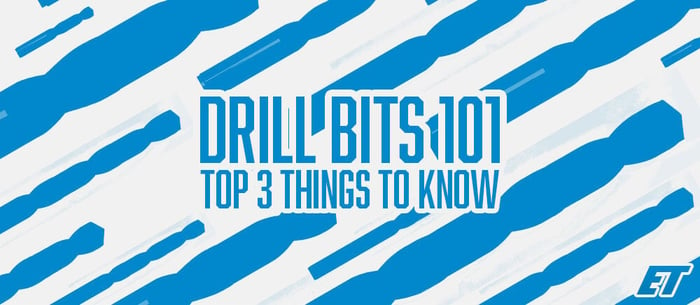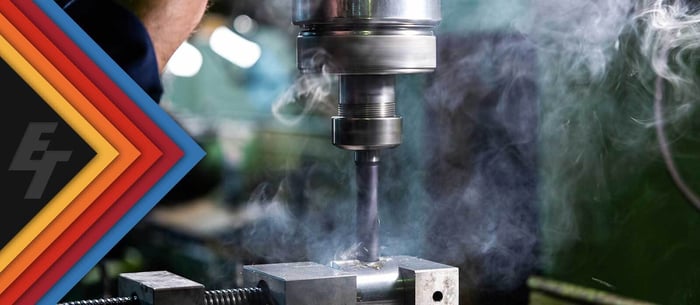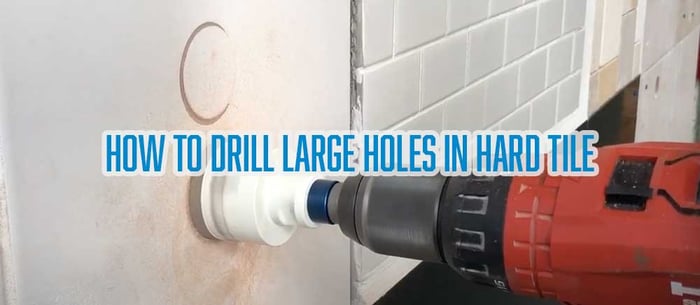Table of Contents
When it comes to choosing the right drill bit for the job, there are three things to consider; material, coating, and the geometry of the tool. We’ll break it all down in a concise way to help clear things up to save you some time.
1. Materials - What’s this thing made out of?
The first thing to think about is the composition of the drilling bit. There are three popular composites and they all serve a different purpose.
1a. High-Speed Steel - The Workhorse
High-Speed Steel (HSS) is the most popular drill bit material for several reasons. High-Speed Steel is readily available, and we have plenty of it right here in the United States. HSS is also extremely versatile. Manufacturers can configure an HSS drill bit for just about any application you can think of.
- Readily available and inexpensive
- Good in drill presses and forgiving in a hand-held drill gun
- Easy to resharpen
1b. M42 Cobalt or HSS with Cobalt Added
M42 Cobalt is high-speed steel with 8-10% Cobalt added in order to increase the hardness and endurance of the tool. You can pretty much expect the same characteristics as a standard HSS drill, but with increased performance across the board.
- Will outlast standard HSS tools
- Better heat and wear resistance
- Easy to resharpen
1c. Carbide - If Superman was a Drill Bit
Solid Carbide drill bits are the most expensive but they will outlast other drill bit materials by a longshot. A Carbide drill will outlast a Cobalt drill by at least twenty times, reducing the cost-per-hole significantly.
One characteristic of Carbide is that it’s brittle, so it won’t flex. This makes Carbide a bad choice for hand drilling. If you’re running a CNC or frequently use a drilling press, this material is worth the investment.
Carbide drills allow for a Through Spindle Coolant system or TSC as it’s known. In situations where you’re drilling deep into very hard materials, the feeding of coolant through the drill allows for better chip evacuation and self-cooling. This also helps to prevent wear, which is nice since TSC drill bits are pricey.
- The most expensive in terms of up-front costs
- Has the best drill-to-hole ratio
- Can be run much faster (three to five times), decreasing the time needed to produce holes
- Provides the best heat and chip resistance
- Allows for Through Spindle Coolant system or TSC
- Will outlast M42 Cobalt by at least a factor of 10-20
2. Coatings - The protective shield!

Throw a good coating on any drill bit and you’ll completely change its characteristics. Coatings extend tool life and improve cutting performance. We’ve selected a few of the most popular coatings to keep things simple, so let’s jump in.
2a. Bright Finish
Bright Finish is a funny term because these drill bits are actually uncoated. Simply put, this keeps costs down.
- Inexpensive
- Great for drilling into low-carbon steel and aluminum.
2b. Black Oxide
Black Oxide finishes increase lubricity which helps to resist damage from heat and corrosion. Naturally, this also extends the life of the tool. These bits are best for use on ferrous metals.
- Inexpensive
- More lubricity
- Resists oxidation
- Heat treatment means 50% longer tool life, over Bright Finish
2c. Black & Gold
Black and Gold finish drill bits resist corrosion and breakage while increasing lubricity. These bits are not prone to chipping and flaking.
- One of the most popular coatings for HSS Drills
- An excellent coating for field techs wanting an excellent all-around drill bit
2d. TiN or Titanium Nitride
TiN extends the drill life and is an excellent entry-level coating for machining needs.
- Good entry-level coating for machining
- Not meant for hard materials and high heat transfer
- Gold finish
- For mild steel
2e. AlTiN or Aluminum Titanium Nitride
AlTiN is a couple of steps up from TiN, with extended life and performance. An interesting charismatic is that these do not perform well on aluminum since aluminum is part of the coating.
- Excellent for wet milling of titanium and high-temp material
- Much higher heat tolerance compared to TiN and TiCN.
- Good for use applications where chipping isn’t an issue
- Not great for aluminum drilling
3. Geometry
Geometry is just as important as the material and coating when it comes to the performance and characteristics of a drill bit. Consider that every manufacturer has its own proprietary configurations so we’ll just focus on the general aspects.
3a. Webbing

Skinny drill bits snap more easily than thick drill bits. This is where spending a little more money for heavy-duty geometry is nice. That said, there is much more to drill design than the thickness and it’s not always a priority but it is a nice thing to be aware of.
3b. Length
A shorter drill bit is more rigid which is ideal so you should always use the shortest drill possible. That said, sometimes you have to use a longer drill bit. In these instances, you should at least use the shortest flute-length (cutting portion) possible. Using a drill with an unnecessary long flute length means that you’re choosing to use a less stable drill. This is not advised. The next question to ask is, “How much flute length do I need?” The rule of thumb for determining this is to take the diameter of the drill bit, double that, and then you’ll have the minimal flute length needed above the hole for proper chip evacuation.
- Stubbies drills are great in CNC machines
- Jobbers are good for use in drill presses and in hand-held drill guns.
- There are many lengths for various applications
About flute length
- Two times the drill diameter in flute length, above the hole is enough
- Go too short and chips can pack up inside the flute, causing poor surface finish, hole size, and straightness issues. The drill can even break.
3c. Drill Point Angle
There are actually a handful of drill point angles, but 118º and 135º are the two most common. A 118º drilling point is commonly put on lower-cost, general-purpose drill bits. It’s suitable for mild steel, aluminum, and other soft metals. On the other hand, 135º is for hardened steel and other tougher materials.
- General-Purpose
- Mild steels, aluminum, and other soft metals
- Hard steels and harder, tougher materials

3d. Helix Angle (spiral angle)
A critical feature in twist drills, helix angles determine the process of chip formation. Large helix angles are good at removing soft, long-chipping materials. Small helix angles are good for the removal of hard, short-chipping materials. Note that there is some overlap in how helix angles are categorized.
10º to 29º
- Harder Steels
- Aluminum Alloys
- Good chip evacuation
- Higher fracture resistance
- Better edge strength
19º to 40º Helix Angles
- General Purpose
- Fine for most applications
27º to 45º
- Difficult materials
- Stainless steel
- Low torque requirements and cutting resistance help cut these metal types
3e. Self-Centering Split Point
This is an excellent and underappreciated feature in twist drills. A split-point drill bit prevents walking when starting a cut. Without a split-point, technicians would first need to drill pilot holes or use punches in order to start their cuts. This would, of course, take a lot more time and cut into your bottom line.
- Prevents walking, especially on a curved surface
- Split Points generate less heat and require less force
- Most Cobalt and Carbide Drills feature Split Points
- Not all HSS drill bits manufacturers feature self-centering split points since it’s more expensive to make these cuts. You get what you pay for
- Most HSS drill bit manufacturers do not offer self-centering split-points on drill sizes under 1/16”
That Just About Covers It!
As we said earlier, every manufacturer has its own special sauce when it comes to drill bit design but the high-level points we covered here are universal. We hope that this condensed guide will serve as a foundation and help you understand what to consider when choosing the right drill bits for your upcoming jobs.
If you have any questions at all, please feel free to reach out to our team at (833) 4-ETOOLS. You can also email us at sales@eldoradotools.com.





